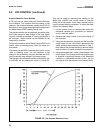
MODEL 54e pH/ORP SECTION 6.0
THEORY OF OPERATION
6.9 PID CONTROL (continued)
Proportional Mode (Gain)
The simplest control is proportional. Proportional may
also be referred to as sensitivity or gain. Although these
terms may refer to a different version of proportional,
the control function is still fundamentally the same - the
error from set point is multiplied by this factor to pro-
duce the output.
The Model 54e pH/ORP's proportional mode is
referred to as proportional "band" which is config-
urable from 0 to 299%. For good control of a specific
process, the proportional band must be properly
adjusted. The proportional band is the percent of the
analog output span (the difference between the 4 (or 0)
mA and 20 mA settings) through which the measured
variable must move to change the output from mini-
mum to maximum. The larger the proportional band,
the less the controller reacts to changes in the
measured variable. As the proportional band is
made smaller, the reaction of the controller
increases. At 0 proportional band, the proportional-
only controller behaves like an on/off controller (an
alarm set at 20 mA).
Most processes require that the measured variable be
held at the set point. The proportional mode alone will
not automatically do this. Proportional alone will only
stabilize the measured variable at some offset to the
actual control point. To control at an exact setpoint,
proportional plus integral mode is used.
Proportional (Gain) Plus Integral (Reset)
For the automatic elimination of deviation, I (Integral
mode), also referred to as Reset, is used. The propor-
tional function is modified by the addition of automatic
reset. With the reset mode, the controller continues to
change its output until the deviation between measure-
ment and set point is eliminated.
The action of the reset mode depends on the propor-
tional band. The rate at which it changes the controller
output is based on the proportional band size and the
reset adjustment. The reset time is the time required
for the reset mode to repeat the proportional action
once. It is expressed as seconds per repeat,
adjustable from 0-2999 seconds.
The reset mode repeats the proportional action as long
as an offset from the set point exists. Reset action is
cumulative. The longer the offset exists, the more the
output signal is increased.
The controller configured with reset continues to
change until there is no offset. If the offset persists, the
reset action eventually drives the controller output to its
100% limit - a condition known as "reset windup". To
prevent reset windup, a controller with reset mode
should never be used to control a measured variable
influenced by uncorrectable conditions. Once the con-
troller is "wound up", the deviation must be eliminated
or redirected before the controller can unwind and
resume control of the measured variable. The integral
time can be cleared and the "windup" condition quickly
eliminated by manually overriding the Model 54e
pH/ORP's analog output using the simulate tests
feature (detailed in Section 5.4).
Control Loop Adjustment and Tuning
There are several methods for tuning PID loops includ-
ing: Ziegler-Nichols frequency response, open loop
step response, closed loop step response, and trial and
error. Described in this section is a form of the open
loop response method called the process reaction
curve method. The reaction times and control charac-
teristics of installed equipment and real processes are
difficult to predict. The Process Reaction Curve Method
of tuning works well because it is based on the
response of the installed system. This procedure, out-
lined in the following paragraphs, can be used as a
starting point for the P and I settings. Experience has
shown that PID controllers will do a fair job of control-
ling most processes with many combinations of rea-
sonable control mode settings.
51


















